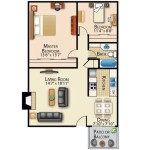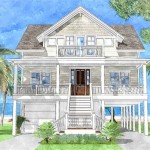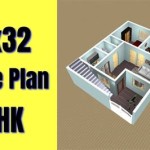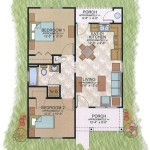Wheelchair Accessible House Plans are architectural designs specifically tailored to meet the needs of individuals who use wheelchairs or have limited mobility. These plans incorporate various accessibility features to ensure a comfortable and safe living environment for wheelchair users. An example of a common feature is the inclusion of wider doorways, allowing for easy wheelchair movement.
The design of Wheelchair Accessible House Plans considers factors such as maneuverability, reach, and transferability. They aim to create homes where wheelchair users can move independently and have full access to all areas of the house. This includes features like roll-in showers, accessible kitchens, and ramps or elevators for multi-level homes.
Transition Paragraph:
In the following sections, we will explore the various aspects of Wheelchair Accessible House Plans. We will delve deeper into the design principles, specific features, and benefits of incorporating accessibility into home design.
When designing Wheelchair Accessible House Plans, it’s essential to consider various important aspects to ensure a comfortable and safe living environment for wheelchair users.
- Wider doorways
- Roll-in showers
- Accessible kitchens
- Ramps or elevators
- Lowered countertops
- Grab bars
- Universal design principles
- Future adaptability
Incorporating these features into home design allows wheelchair users to live independently and access all areas of the house conveniently and safely.
Wider doorways
Wider doorways are a crucial aspect of Wheelchair Accessible House Plans. They allow wheelchair users to easily enter and exit rooms without difficulty, ensuring their independence and mobility throughout the home.
- Standard doorway width: Typically, doorways in residential homes measure around 32 inches in width. However, for wheelchair accessibility, doorways should be widened to at least 36 inches to provide ample space for wheelchairs to pass through.
- Maneuverability: Wider doorways enable wheelchair users to maneuver comfortably, reducing the risk of collisions with door frames or walls. This is particularly important in areas with limited space, such as hallways or doorways leading to bathrooms.
- Transferability: Wider doorways facilitate easy transfer from wheelchairs to other surfaces, such as beds or chairs. This is crucial for individuals who may need assistance with transfers or who use wheelchairs as their primary means of mobility.
- Accessibility for all: Wider doorways not only benefit wheelchair users but also enhance accessibility for individuals with other mobility impairments, such as those using walkers or canes. Creating a universally accessible home ensures that everyone can move around comfortably and safely.
Incorporating wider doorways into Wheelchair Accessible House Plans is essential for creating a home environment that empowers wheelchair users with independence and freedom of movement.
Roll-in showers
Roll-in showers are a key component of Wheelchair Accessible House Plans, providing safe and convenient bathing facilities for wheelchair users. They offer several advantages and features that enhance accessibility and comfort:
- Curbless entry: Unlike traditional showers with raised curbs, roll-in showers have a curbless entry, allowing wheelchair users to roll directly into the shower without any obstacles or barriers. This eliminates the need for stepping over or lifting into the shower, ensuring a seamless and effortless transition.
- Spacious design: Roll-in showers are typically larger than standard showers to provide ample space for wheelchair maneuvering and bathing assistance. This allows wheelchair users to move around comfortably and safely, reducing the risk of slips or falls.
- Non-slip surfaces: Roll-in showers incorporate non-slip flooring and grab bars to ensure stability and prevent accidents. These features minimize the risk of slipping and enhance the safety of wheelchair users while showering.
- Adjustable showerheads: Roll-in showers often include adjustable showerheads that can be positioned at a comfortable height for wheelchair users. This allows them to shower independently without the need for assistance or specialized equipment.
Overall, roll-in showers provide wheelchair users with a dignified and accessible showering experience, enabling them to maintain their independence and privacy during bathing.
Accessible kitchens
Accessible kitchens are designed to meet the needs of individuals who use wheelchairs or have limited mobility. They incorporate various features and modifications to ensure that wheelchair users can move around the kitchen, reach appliances and storage, and prepare meals independently and safely.
- Lowered countertops: Countertops are lowered to a height that allows wheelchair users to comfortably reach and work without straining or reaching over obstacles. This modification enables them to participate in meal preparation and other kitchen tasks without assistance.
- Roll-under sinks: Sinks are designed with open space underneath to allow wheelchairs to roll under and provide access to faucets and controls. This feature eliminates the need for wheelchair users to lean over or reach awkwardly to use the sink, ensuring comfort and independence.
- Accessible appliances: Kitchens are equipped with appliances that are accessible to wheelchair users. This includes ovens and cooktops with front controls, dishwashers with lowered controls, and refrigerators with pull-out shelves. These modifications make it easier for wheelchair users to operate appliances without assistance.
- Universal design principles: Accessible kitchens adhere to universal design principles, creating a space that is usable and comfortable for individuals with a wide range of abilities and disabilities. This includes features such as lever handles, adjustable shelving, and clear pathways for wheelchair movement.
By incorporating these features, accessible kitchens empower wheelchair users with the ability to cook, prepare meals, and participate in kitchen activities independently and with dignity.
Ramps or elevators
Ramps and elevators are essential components of Wheelchair Accessible House Plans, providing wheelchair users with safe and convenient access to different levels of a home. Here’s a detailed explanation of each option:
Ramps
Ramps are inclined planes that allow wheelchair users to access different levels of a home without the need for stairs. They are typically installed outdoors to connect the ground level to an elevated porch or entrance. Ramps must adhere to specific building codes and standards to ensure a safe and accessible gradient. Key considerations for ramps include:
- Slope: The slope of a ramp is crucial for wheelchair accessibility. It should not be too steep or too shallow to ensure a smooth and manageable transition for wheelchair users. Building codes typically specify a maximum slope of 1:12, meaning a 1-foot rise for every 12 feet of horizontal length.
- Surface: The surface of a ramp should be slip-resistant and provide good traction for wheelchairs. Common materials used for ramps include concrete, asphalt, or rubberized surfaces.
- Width: Ramps should be wide enough to accommodate wheelchairs comfortably. The minimum recommended width is 36 inches to allow for easy maneuvering and passing of wheelchairs.
- Handrails: Handrails on both sides of a ramp provide additional support and stability for wheelchair users, especially when navigating slopes or uneven surfaces.
Elevators
Elevators are enclosed vertical lifts that provide wheelchair users with access to different floors of a home. They are particularly useful in multi-level homes where ramps may not be feasible or practical. Elevators offer several advantages:
- Vertical access: Elevators allow wheelchair users to travel between floors quickly and easily, eliminating the need to negotiate stairs or ramps.
- Convenience: Elevators provide a convenient and comfortable way for wheelchair users to access all levels of their home, enhancing their independence and quality of life.
- Safety: Elevators are enclosed and controlled, ensuring a safe and secure mode of transportation for wheelchair users.
When considering elevators for Wheelchair Accessible House Plans, factors such as space availability, cost, and maintenance requirements should be taken into account. Elevators typically require a dedicated shaft or enclosure, which may impact the overall design and layout of the home.
Lowered countertops
Lowered countertops are a crucial aspect of Wheelchair Accessible House Plans, as they enable wheelchair users to comfortably and independently perform various kitchen tasks. By lowering the height of countertops, wheelchair users can reach and use appliances, sinks, and other work surfaces without straining or relying on assistance.
- Accessibility: Lowered countertops provide wheelchair users with direct and easy access to kitchen surfaces. They can independently prepare meals, wash dishes, and engage in other kitchen activities without difficulty, promoting their independence and self-sufficiency.
- Ergonomics: Lowered countertops improve ergonomics for wheelchair users. When countertops are at an appropriate height, wheelchair users can maintain a comfortable posture while working in the kitchen. This helps prevent strain, fatigue, and discomfort, ensuring a more enjoyable and efficient cooking experience.
- Safety: Lowered countertops enhance safety for wheelchair users. By eliminating the need to reach or lean over high surfaces, the risk of spills, burns, or other accidents is reduced. Wheelchair users can safely and confidently maneuver around the kitchen without compromising their safety.
- Universal design: Lowered countertops adhere to universal design principles, creating a kitchen space that is accessible and usable by individuals with a wide range of abilities and disabilities. They ensure that everyone, regardless of their physical limitations, can participate in kitchen activities and enjoy a comfortable and functional cooking environment.
Incorporating lowered countertops into Wheelchair Accessible House Plans is essential for empowering wheelchair users with the ability to fully utilize their kitchens and participate in meal preparation and other kitchen tasks independently and with dignity.
Grab bars
Grab bars are essential safety features in Wheelchair Accessible House Plans, providing stability, support, and fall prevention for wheelchair users. They are strategically placed throughout the home, particularly in areas where wheelchair users may need additional assistance or support.
Grab bars are typically installed near toilets, showers, bathtubs, and sinks to assist wheelchair users with transfers and maneuvering in these spaces. They are also commonly found in hallways, doorways, and along ramps to provide support while moving through the home. Grab bars come in various shapes, sizes, and finishes to match the dcor and functionality of the home.
The proper installation of grab bars is crucial for their effectiveness and safety. They should be securely mounted into wall studs or reinforced backing to ensure they can withstand the force applied by wheelchair users. The height and placement of grab bars should be customized to the individual user’s needs and preferences, ensuring they can reach and grip the bars comfortably and safely.
In addition to providing support and stability, grab bars also enhance independence for wheelchair users. They allow individuals to navigate their homes more confidently and independently, reducing the need for assistance from others. Grab bars empower wheelchair users to perform daily tasks with greater ease and dignity, promoting their overall well-being and quality of life.
Universal design principles
Universal design principles are a set of guidelines and best practices that aim to create environments and products that are accessible, usable, and inclusive for individuals with a wide range of abilities and disabilities, including wheelchair users.
When applied to Wheelchair Accessible House Plans, universal design principles ensure that the home environment is not only accessible to wheelchair users but also comfortable, safe, and aesthetically pleasing for all occupants.
Key universal design principles include:
- Equitable use: The design should be usable by people with diverse abilities, regardless of their age, size, ability, or disability.
- Flexibility in use: The design should accommodate a wide range of individual preferences and abilities, allowing for different methods of use.
- Simple and intuitive use: The design should be easy to understand and use, minimizing the need for instructions or specialized knowledge.
- Perceptible information: The design should communicate necessary information effectively, regardless of the user’s sensory abilities.
- Tolerance for error: The design should minimize the risk of accidental or unintended actions, and provide clear and understandable feedback.
- Low physical effort: The design should require minimal physical effort to operate, reducing the risk of fatigue or strain.
- Size and space for approach and use: The design should provide adequate space for wheelchair users and assistive devices to approach, reach, manipulate, and use elements.
By incorporating universal design principles into Wheelchair Accessible House Plans, architects and designers can create homes that are not only accessible but also welcoming and comfortable for all individuals, regardless of their abilities.
Universal design benefits everyone, not just individuals with disabilities. It promotes inclusivity, enhances safety, and creates more livable and enjoyable environments for all.
Future adaptability
Future adaptability in Wheelchair Accessible House Plans refers to the ability of a home to be modified and adapted to meet the changing needs of wheelchair users over time. As individuals’ needs evolve, their homes should be able to accommodate these changes without extensive renovations or major structural alterations.
Incorporating future adaptability into Wheelchair Accessible House Plans involves considering various aspects of the home’s design and construction. Here are some key considerations:
- Modular design: Using a modular design approach allows for easy reconfiguration of spaces and the addition of new features as needed. Modular components can be added or removed to accommodate changing accessibility requirements.
- Adjustable features: Incorporating adjustable features, such as height-adjustable countertops, sinks, and showerheads, provides the flexibility to adapt the home to different users and their changing needs.
- Universal design principles: Adhering to universal design principles ensures that the home is accessible and usable for individuals with a wide range of abilities, including those who may require future adaptations.
- Clear circulation paths: Providing clear and wide circulation paths throughout the home allows for easy movement of wheelchairs and other assistive devices, both now and in the future.
By considering future adaptability in Wheelchair Accessible House Plans, homeowners can create homes that will meet their evolving needs over time, ensuring a comfortable and independent living environment throughout their lives.
In addition to the above considerations, future adaptability also involves:
- Electrical upgrades: Installing additional electrical outlets and circuits can accommodate future assistive technologies or medical equipment.
- Smart home technology: Integrating smart home technology, such as voice-activated controls and automated lighting, can enhance accessibility and independence for wheelchair users.
- Outdoor space: Designing outdoor spaces with accessible features, such as ramps and raised garden beds, allows for future enjoyment and use.
By incorporating these elements into Wheelchair Accessible House Plans, homeowners can create homes that are not only accessible today but also adaptable to their future needs, promoting lifelong independence and well-being.










Related Posts








